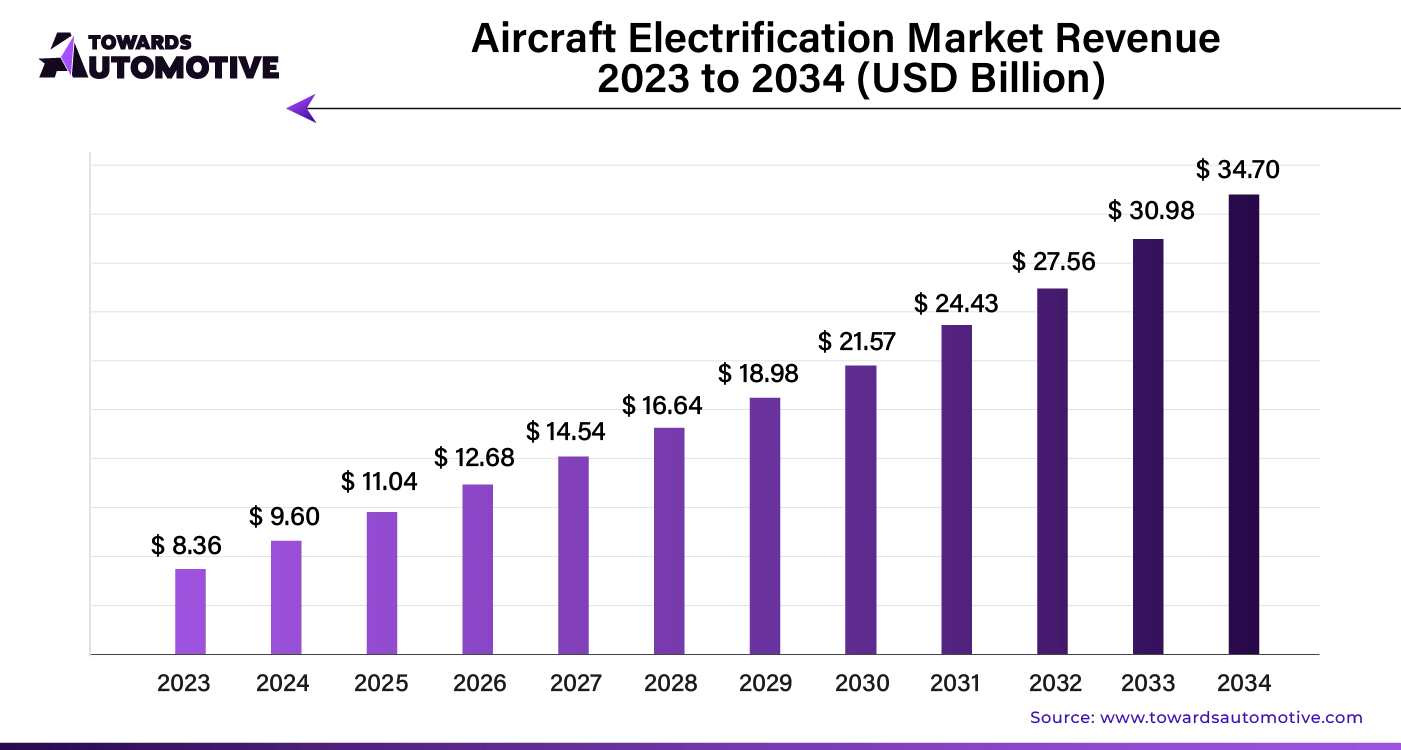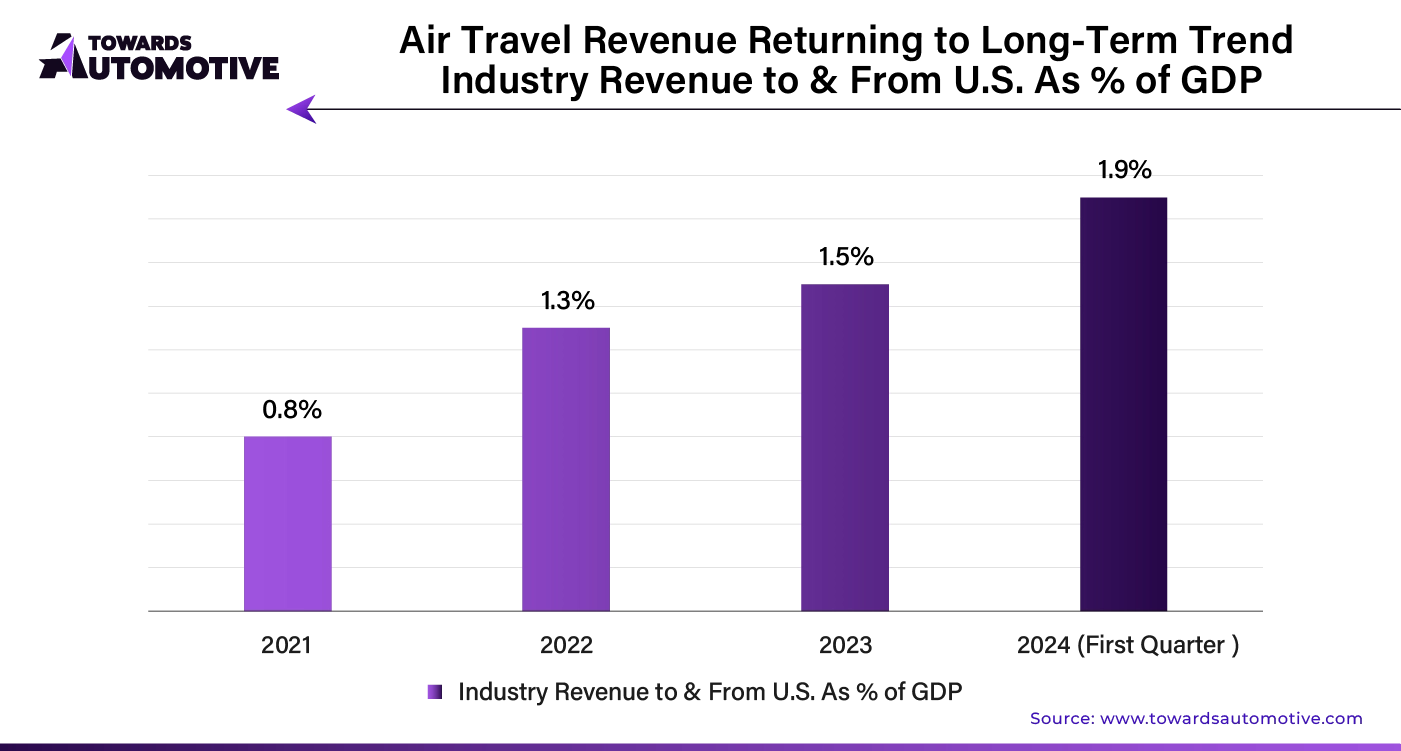March 2025
The global aircraft electrification market size is calculated at USD 8.36 billion in 2023 and is expected to be worth USD 34.70 billion by 2034, expanding at a CAGR of 14.94% from 2024 to 2034.

Unlock Infinite Advantages: Subscribe to Annual Membership
Aircraft are increasingly under scrutiny for their environmental impact due to fuel emissions. In response, the industry is rapidly adopting electrification. This shift replaces expensive mechanical components with cost-effective electrical systems, reducing both installation and maintenance costs. Electrification also addresses noise pollution, a common issue with traditional aircraft. While some aircraft have transitioned to full electrification, others use hybrid systems that combine electric and conventional technologies. With growing regulatory pressure, electrification is becoming essential for meeting sustainability standards set by governments.
Lithium-ion batteries are driving aircraft electrification, offering greater efficiency. Ongoing research aims to enhance battery performance further. Electrified aircraft are increasingly used for humanitarian missions due to their compact size and low operational costs.
The military is also exploring electric aircraft, with more tests being conducted to assess their viability. Innovations in electric systems, including actuators and flight control systems, are driving dynamic demand in the aircraft electrification market. The automotive market valued at USD 4,070.19 billion in 2023, is experiencing growth and is projected to surpass USD 6,678.28 billion by 2032, with a significant CAGR of over 5.66%.
Electrification is gaining popularity for short-distance flights, helping airlines save on fuel and maintenance costs. Commercial aircraft are progressively adopting electric systems to reduce costs and environmental impact.
However, inadequate airport infrastructure, such as insufficient charging points, poses a challenge. Additionally, concerns about potential electrical system failures mid-flight could hinder market growth. Despite these challenges, startups and small companies, supported by public research, are making significant progress in aircraft electrification.

AI is set to revolutionize the aircraft electrification market by driving significant advancements in efficiency and innovation. By leveraging AI-driven predictive maintenance, airlines can anticipate equipment failures before they occur, reducing downtime and extending the life of electrical systems. AI algorithms optimize energy management, ensuring that aircraft operate at peak efficiency and consume less fuel. This optimization leads to cost savings and a reduced environmental footprint.
AI also accelerates the development of advanced electric propulsion systems. Machine learning models analyze vast amounts of data to improve battery performance and reliability, propelling the industry towards more sustainable solutions. Furthermore, AI enhances the design process through advanced simulations, allowing for more accurate predictions of system performance and safety.
AI's role in automating manufacturing processes streamlines production, reduces errors, and accelerates time-to-market for new technologies. This efficiency boost translates into faster adoption of electric aircraft and an overall growth in the market. As AI continues to advance, it will drive innovation and competitive advantage in the aircraft electrification sector, marking a pivotal shift towards smarter, greener aviation.
The aircraft electrification market hinges on a well-coordinated supply chain to ensure smooth operations. At its core, the supply chain begins with the sourcing of critical raw materials, including advanced semiconductors and high-performance batteries. Suppliers of these materials must adhere to stringent quality standards to meet the demands of aircraft electrification.
Manufacturers then utilize these materials to produce components such as electric propulsion systems and energy storage units. Each component undergoes rigorous testing to ensure reliability and safety. Efficient logistics are crucial as these components are transported to assembly facilities, where they are integrated into aircraft systems.
The supply chain also involves collaboration between technology providers and aircraft manufacturers. These partnerships facilitate the exchange of technical expertise and innovations, driving advancements in electrification technologies. Additionally, regular communication and updates between all stakeholders help to preempt and address potential disruptions.
Finally, end-users, including airlines and aerospace companies, rely on timely delivery and robust support services to integrate and maintain electrified aircraft systems. By optimizing each link in the supply chain, the aircraft electrification market can achieve greater efficiency and reliability.
The Aircraft Electrification market is rapidly evolving due to advancements in technology and the push for greener aviation solutions. The ecosystem is driven by several key components: electric propulsion systems, energy storage solutions, power management systems, and electric aircraft components.
Electric propulsion systems are revolutionizing aviation by offering more efficient and environmentally friendly alternatives to traditional jet engines. Leading companies such as Boeing and Airbus are at the forefront, investing heavily in research and development to integrate electric propulsion into their aircraft designs.
Energy storage solutions, including advanced battery technologies, are essential for efficient aircraft operation. Companies like Siemens and GE Aviation are developing high-capacity, lightweight batteries to meet the demands of electric aviation.
Power management systems ensure the reliable distribution and management of electrical power across aircraft. Honeywell and Thales are leading efforts in this area, creating sophisticated systems that optimize power usage and enhance overall performance.
Electric aircraft components, including motors and controllers, are crucial for successful electrification. Companies like Rolls-Royce and Safran are innovating in this space, providing cutting-edge technologies that drive the future of electric aviation.
Together, these components and companies shape the future of aircraft electrification, paving the way for more sustainable and efficient air travel.
Batteries at the Forefront of Aircraft Electrification
| Top Component: | Batteries |
| CAGR (2024-2034): | 15% |
Batteries are pivotal for aircraft electrification, playing key roles in emergency power and fault clearing. Their critical functions make them highly sought after among electrical components. For example, lithium-ion batteries are boosting aircraft performance, driving the segment’s anticipated 15% CAGR over the next decade.
Power Generation Fuels Aircraft Electrification
| Top Application: | Power Generation |
| CAGR (2024-2034): | 14.8% |
The power generation segment is expected to grow at a 14.8% CAGR during the forecast period. Electric generators and alternators are increasingly replacing traditional fuel sources due to their efficiency and lower environmental impact. This shift is driven by growing concerns about fuel usage and the benefits of modern electrical power systems.
Asia Pacific: Rapid Expansion Driven by Increased Cargo Demand
Asia Pacific is becoming a significant player in the aircraft electrification market, with new airlines and rising cargo needs fueling growth.
Technological Advancements Enhancing Europe and North America
Technological breakthroughs in aircraft are accelerating the adoption of electric systems in Europe and North America. These developed regions are home to major players investing significantly in research and development.
South Korea: Leading with Fully Electric Aircraft
South Korea is anticipated to experience a 16.8% CAGR over the next decade. The country is heavily investing in fully electric aircraft. Startups like Toff Mobility are pioneering electric flights for passengers and cargo, supported by government initiatives aimed at reducing greenhouse gas emissions.
Japan: Significant Investment in Aircraft Electrification
Japan’s market is projected to grow at a 16.2% CAGR. Both private and public sectors are making substantial investments, including the Japanese government's $200 million allocation for aircraft electrification research. Japan Airlines is investigating hybrid electric aviation as part of this effort.
China: Advancing Battery-Operated Aircraft to Meet Demand
China’s market is expected to expand at a 15.8% CAGR. Chinese firms are focusing on developing electric aircraft to handle the growing passenger numbers due to an expanding middle class.
United Kingdom: Research and Collaboration Driving Progress
The UK market is set to grow at a 16.3% CAGR. Research initiatives, such as those by Cranfield University and the 2ZERO project, are advancing the development of short-range electric aircraft, with support from partners like Rolls-Royce Electrical.
United States: Moving Closer to Electric Passenger Flights
The US market is forecasted to grow at a 15.5% CAGR. Companies like United Airlines are working towards electric passenger flights by 2028. The startup ecosystem, with companies like ZeroAvia, is also contributing innovative solutions to the electrification market.
The aircraft electrification market is diverse, featuring a mix of major multinational companies, innovative startups, and public aviation enterprises. Key players are heavily investing in research and development and forming partnerships to boost progress.
Recent developments include:
By Component
By Application
By Phase
By Region
March 2025
March 2025
February 2025
February 2025
We offer automotive expertise for market projections and customizable research, adaptable to diverse strategic approaches.
Contact Us